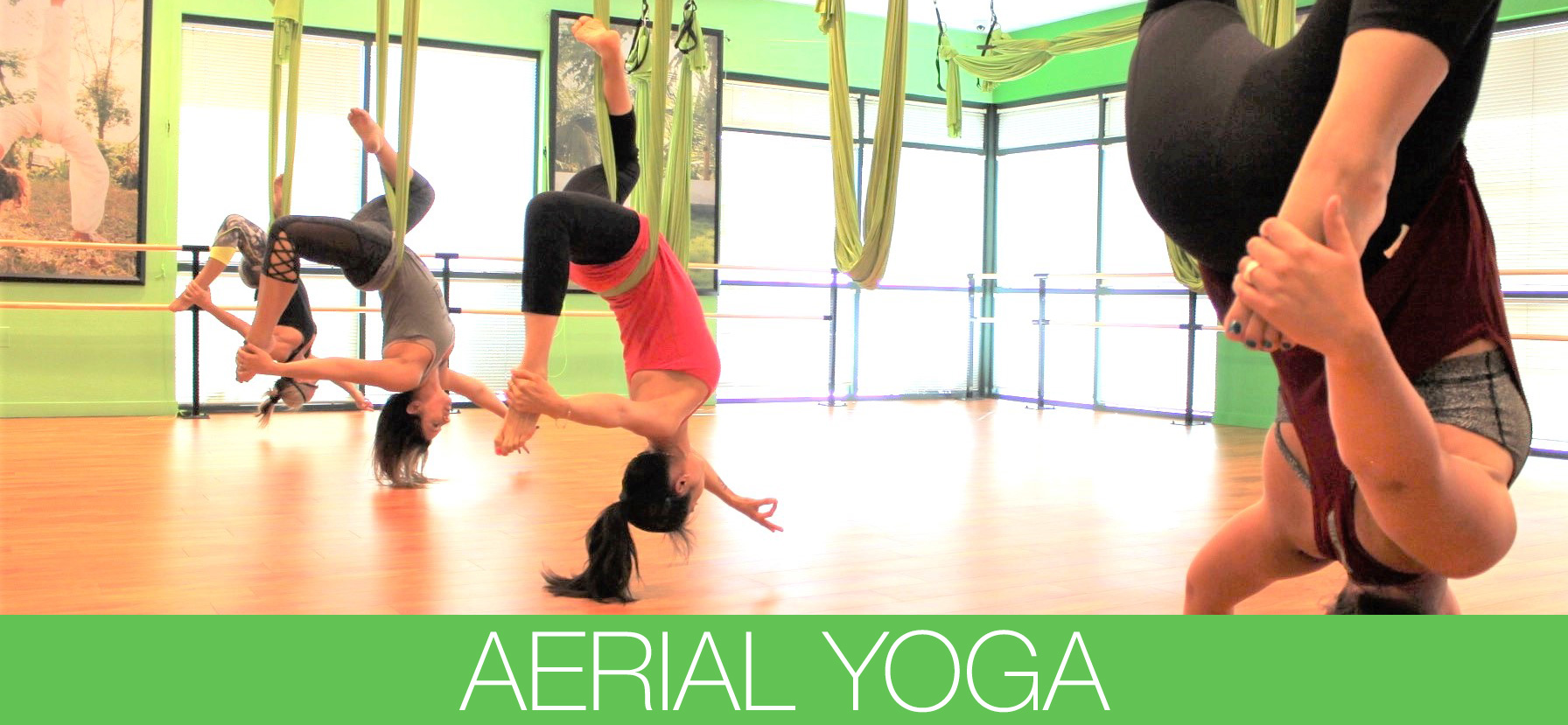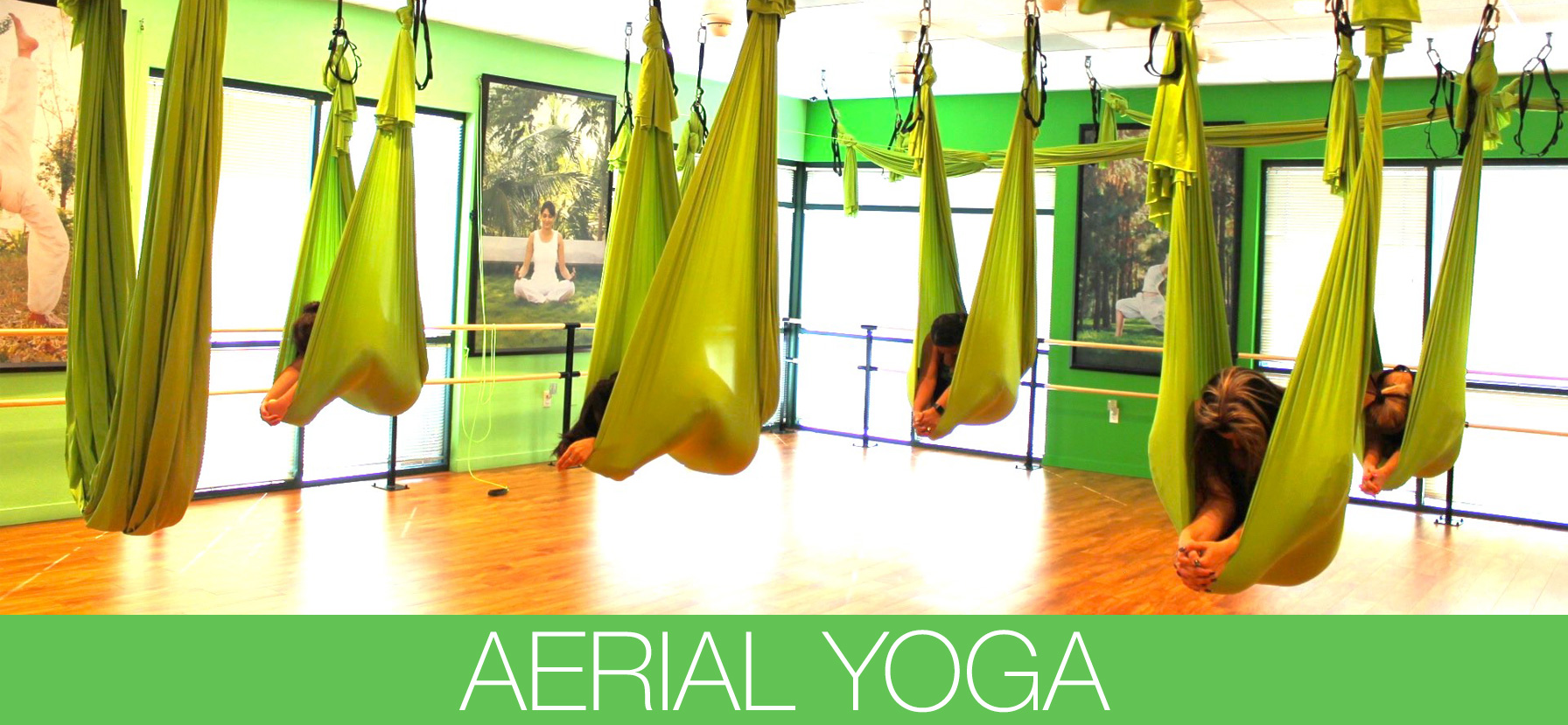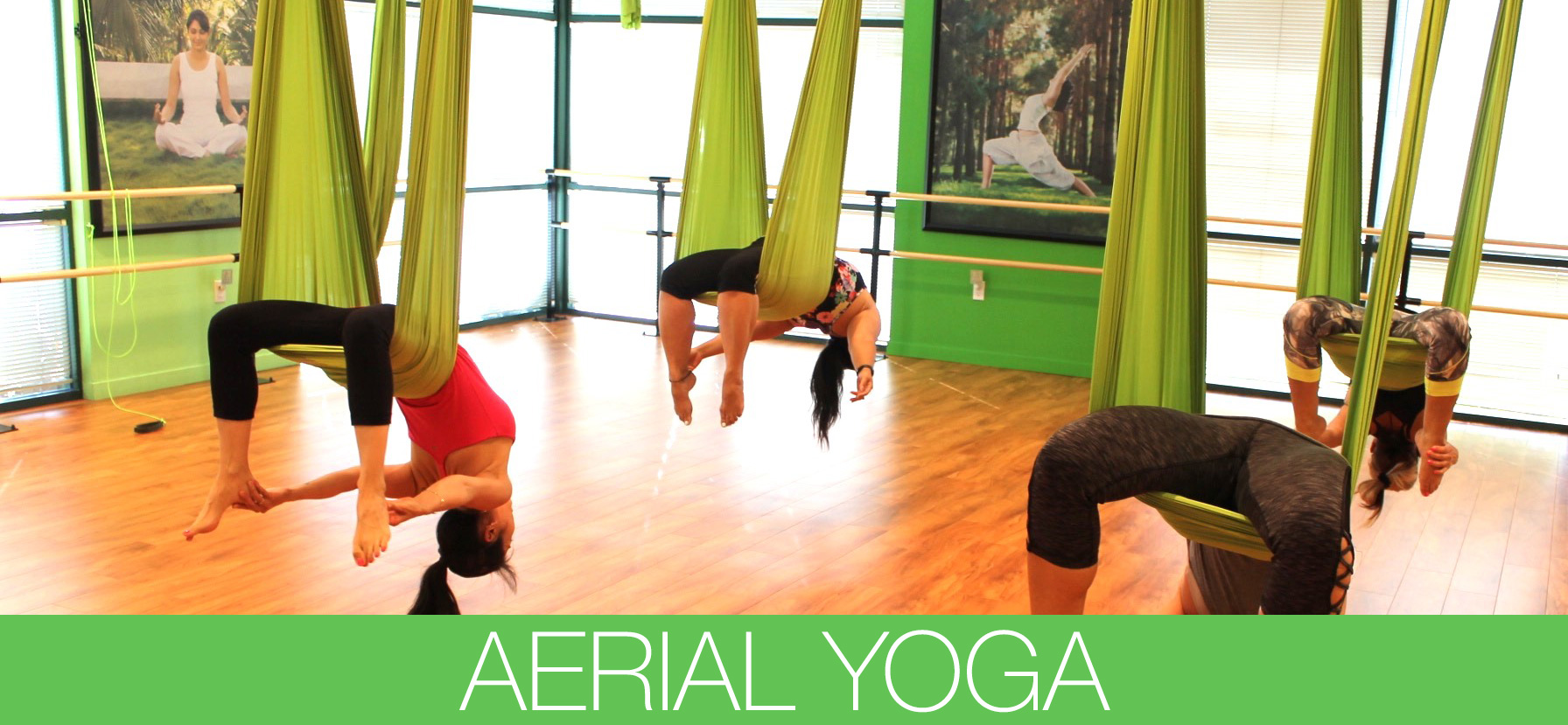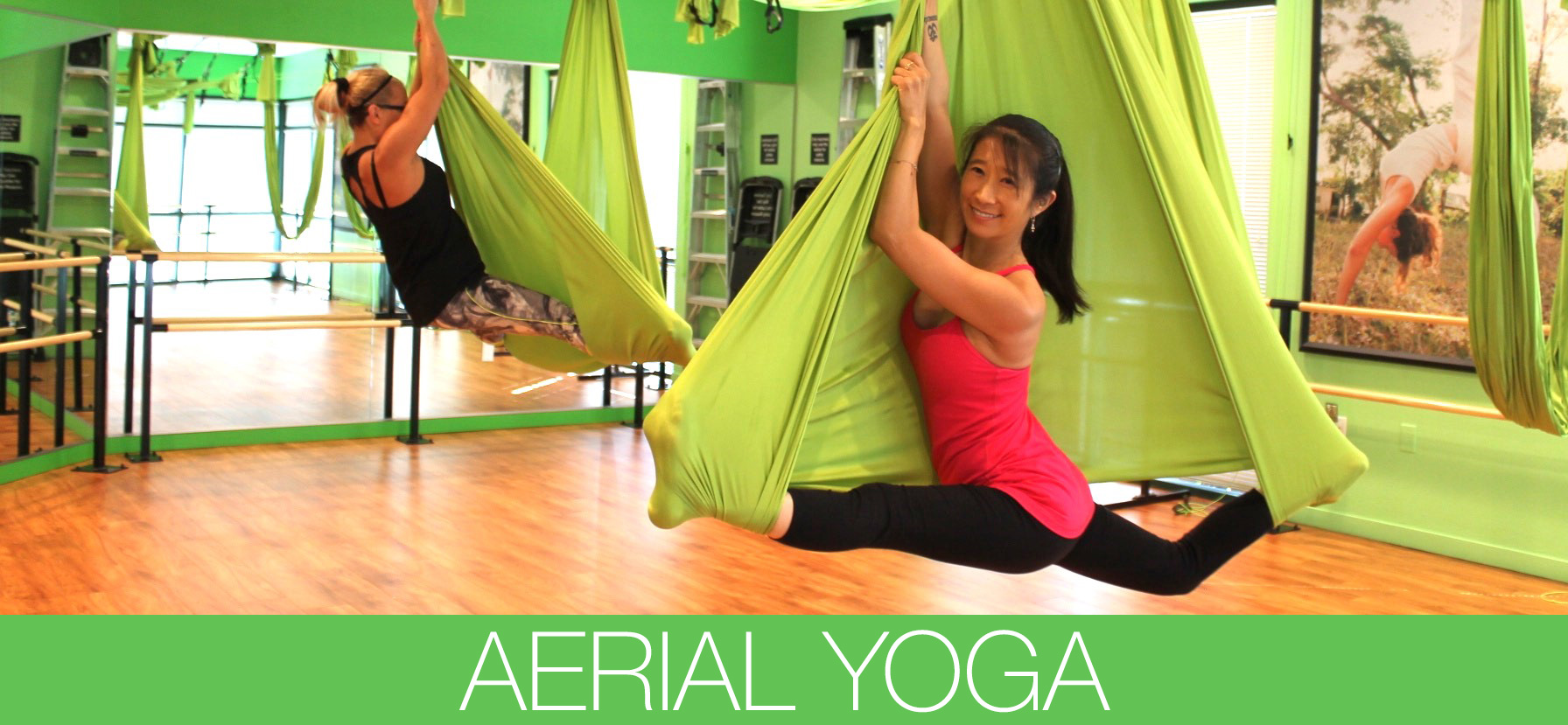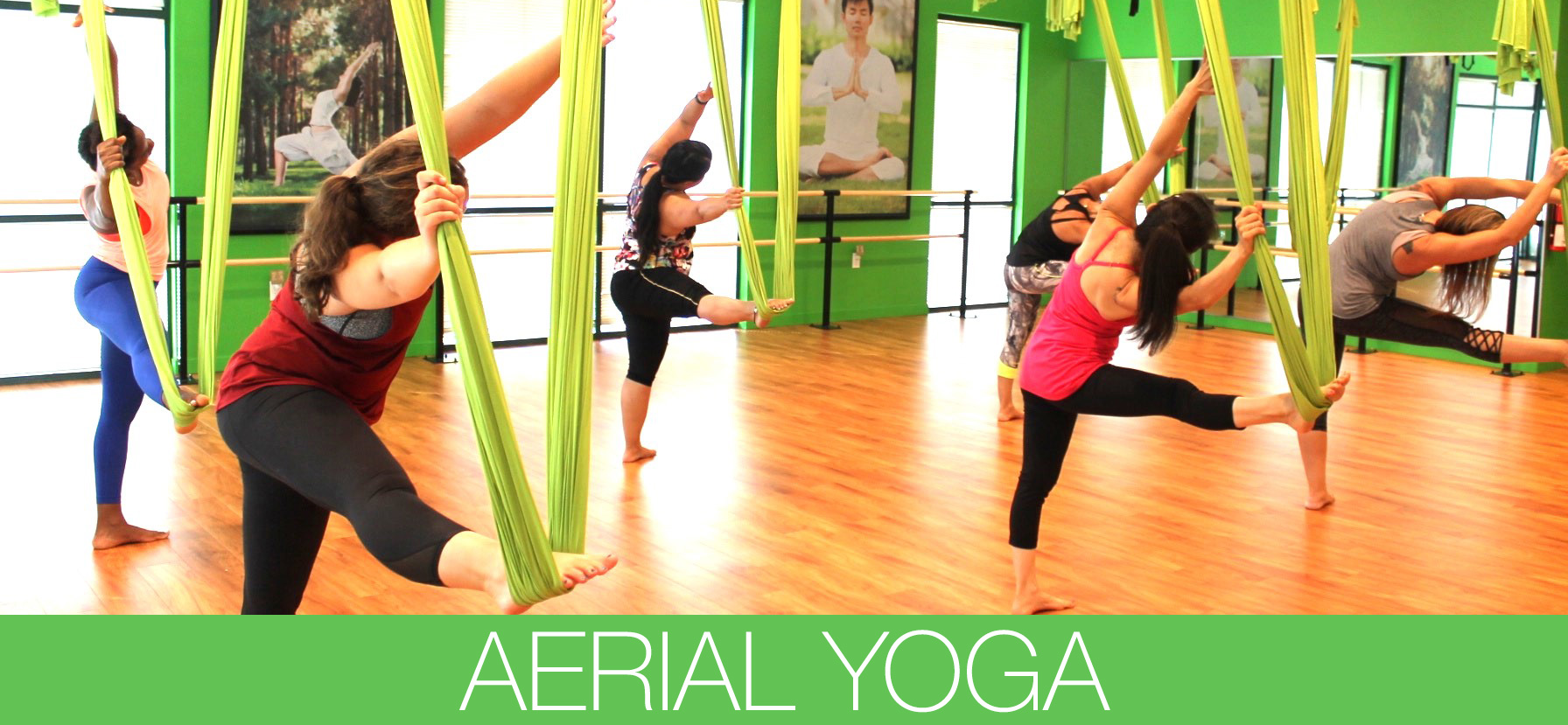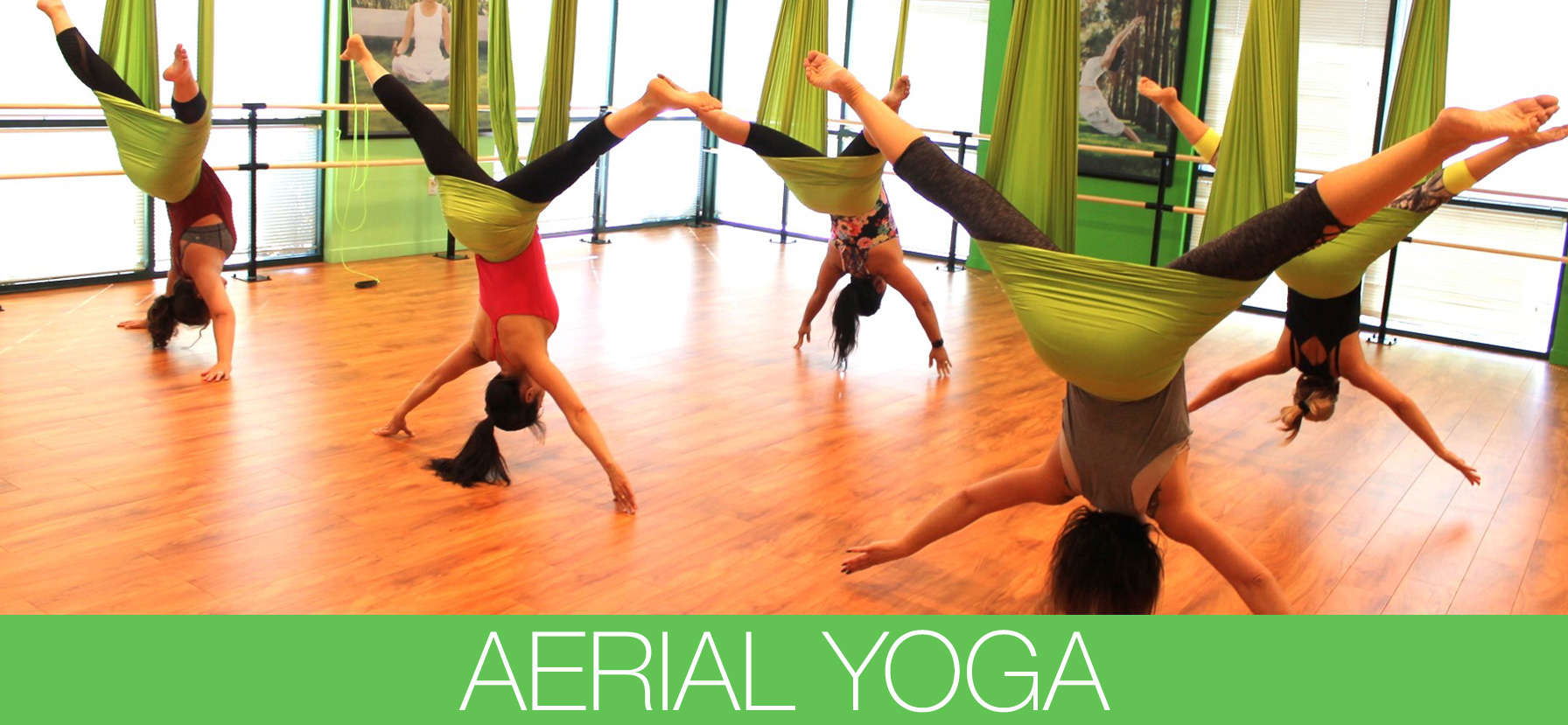Aerial Yoga
16 years +
Aerial Gentle Stretch:
Have you always wanted to try Aerial Yoga, but going upside down or climbing are not for you? Then, you may want to try this more relaxing class. Enjoy some gentle yoga poses that don’t go upside down. Lay or sit softly in the luxurious fabric for full body stretches and relaxation. Stretch your legs with one leg on the floor and the other in the fabric. Melt away your daily stress.
Aerial Yoga:
Before the class begins, the aerial fabric height is custom positioned by the teacher to be at each student’s individual hip level height. So, the fabric is never more than about 3 feet above the floor. Inversions are always optional. Variations will be shown for poses. The fabric hammock is a wonderful prop, much like a strap or block, assisting in body alignment, opening awareness, deepening stretches, and creating spinal decompression. When the spine is more open, pain may be reduced. As the class moves along, students may choose to remain safely and comfortably in a pose they enjoy. They may find it relaxing to simply lounge in the fabric, or just want to enjoy a certain stretch longer. This is encouraged to fulfill each person’s aerial class experience.
What is Aerial Yoga:
Aerial Yoga is a practice that fuses together the two traditional art forms of yoga and aerial dance. For centuries people have found freedom while flowing through yoga postures as well as dancing in the skies. This allows practitioners to sink into their practice more quickly, to deepen stretches, to find proper alignment naturally, and to reap the benefits of inversions without strain on the joints of the body.
Aerial yoga is also known by the name anti-gravity yoga. When you’re in an aerial yoga class, you’ll be in a silk hammock that supports your body weight so that you’re suspended in mid-air, allowing you to do many of the same poses as in mat yoga, but without the obstacle of gravity. This style can be adapted for both beginners and more experienced practitioners.
History of Aerial Yoga
The first known yogi to use ropes and suspension to achieve more difficult inversions was B. K. S. Iyengar in the 1990s, but aerial yoga did not catch on as its own discipline until the early 2000s. It was then that a group of fitness teachers got together to combine anti-gravity principles, fitness, yoga, dance, and acrobatics to help their students to achieve a higher level of flexibility and a greater variety of poses. Broadway dancer and gymnast yoga teacher Michelle Dortinac, Cirque du Soleil artist Carmen Curtis, and aerial dancer Rebekah Leach used their experiences from their individual disciplines to build and influence the early days of aerial yoga development and propel it to its current level of popularity. Since then, it’s grown to become popular in countries across the world where there are trainings to receive a license to teach anti-gravity yoga. Flying yoga has developed from this specialty as well and typically is done with the use of a simple belt instead of a hammock to help students get into the various yoga postures.
Benefits of Doing Aerial Yoga
Aerial yoga incorporates all of the principles of mat yoga and therefore provides the same benefits, but there are added advantages of using the hammocks and anti-gravity principles of flying yoga and aerial yoga.
Relieves back pain: Generally, there is less pressure on your joints when in the hammock, making it a good option for those who find mat yoga too strenuous. You won’t have any strain on your spine and this is a big plus for people who experience back pain.
Greater flexibility: This yoga style gives you more range of motion, so you can safely stretch your tendons and muscles and have more space to move allowing you to do more postures than you would on the floor.
Better control of your breathing: Breath control is a benefit of yoga that can be used in daily life. When you’re up in the air you can relax your body without restriction, and eventually, you should be able to improve your lung capacity.
Improved Mood
Are you someone who has anxiety attacks or is going through a difficult time? With aerial yoga, you can be more at ease as you meditate and have more of a focus on the positive. When you’re inverted you should have increased energy, balance, and focus since blood will flow to your brain more and provide it with oxygen to improve your brain’s functioning.
Burn calories
Aerial yoga combines many disciplines and uses several muscle groups, allowing you to burn calories without as much strain as seen in other workout methods. The wide variety of poses engage all of your muscles, building and strengthening your core.
Allows for easier inversions: Inversions are a very beneficial part of practicing yoga, but they are inaccessible to many people for a variety of reasons. When gravity is removed from the equation, those who need assistance to achieve inversions in mat yoga can suddenly do them on their own, with the help of the hammock. Being able to suddenly do more difficult poses allows access to more of the benefits of yoga practice.
It can be intimidating the first time you take an anti-gravity yoga class but it is well worthwhile. Trust in us at the YogaCoreFit studio to help you feel more comfortable with aerial yoga in Vacaville, CA.
Aerial Yoga is the uniquely enhanced practice of traditional hatha yoga using a soft fabric hammock. Each fabric hammock supports up to 2000 lbs, and is safely suspended a few feet off the floor. The fabric hammock is a wonderful prop, much like a strap or block, assisting in body alignment, opening awareness, deepening stretches, and creating spinal decompression.
Reducing spinal decompression may help eliminate nerve compression, bringing nutrients and water into the spine and other areas of the body.
Since inter-vertebral discs have poor circulation, they depend upon receiving their nutrition through the vertebrae end disks above and below. When the spine has more space, it is less compressed and chronic back pain may become less. With the weight of the body partially or fully supported, we can explore and create more space in our bodies as intended in yoga practice. Without the compression of the joints and spine we can achieve proper posture and alignment through relaxation rather than effort, therefore finding a more balanced expression of each pose.
Aerial Yoga Class Things to Know
• Instructor supervision required to get on and move around on a hammock for safety reasons.
• Wear deodorant and have clean skin.
• Remove all jewelry, watches, and hair clips (place small personal items in small mesh bags provided).
• Only one person per hammock (max 300lbs).
What is Aerial Yoga:
Aerial yoga is also known by the name anti-gravity yoga. When you’re in an aerial yoga class, you’ll be in a silk hammock that supports your body weight so that you’re suspended in mid-air, allowing you to do many of the same poses as in mat yoga, but without the obstacle of gravity. This style can be adapted for both beginners and more experienced practitioners.
History of Aerial Yoga
The first known yogi to use ropes and suspension to achieve more difficult inversions was B. K. S. Iyengar in the 1990s, but aerial yoga did not catch on as its own discipline until the early 2000s. It was then that a group of fitness teachers got together to combine anti-gravity principles, fitness, yoga, dance, and acrobatics to help their students to achieve a higher level of flexibility and a greater variety of poses. Broadway dancer and gymnast yoga teacher Michelle Dortinac, Cirque du Soleil artist Carmen Curtis, and aerial dancer Rebekah Leach used their experiences from their individual disciplines to build and influence the early days of aerial yoga development and propel it to its current level of popularity. Since then, it’s grown to become popular in countries across the world where there are trainings to receive a license to teach anti-gravity yoga. Flying yoga has developed from this specialty as well and typically is done with the use of a simple belt instead of a hammock to help students get into the various yoga postures.
Benefits of Doing Aerial Yoga
Aerial yoga incorporates all of the principles of mat yoga and therefore provides the same benefits, but there are added advantages of using the hammocks and anti-gravity principles of flying yoga and aerial yoga.
Relieves back pain: Generally, there is less pressure on your joints when in the hammock, making it a good option for those who find mat yoga too strenuous. You won’t have any strain on your spine and this is a big plus for people who experience back pain.
Greater flexibility: This yoga style gives you more range of motion, so you can safely stretch your tendons and muscles and have more space to move allowing you to do more postures than you would on the floor.
Better control of your breathing: Breath control is a benefit of yoga that can be used in daily life. When you’re up in the air you can relax your body without restriction, and eventually, you should be able to improve your lung capacity.
Improved Mood
Are you someone who has anxiety attacks or is going through a difficult time? With aerial yoga, you can be more at ease as you meditate and have more of a focus on the positive. When you’re inverted you should have increased energy, balance, and focus since blood will flow to your brain more and provide it with oxygen to improve your brain’s functioning.
Burn calories
Aerial yoga combines many disciplines and uses several muscle groups, allowing you to burn calories without as much strain as seen in other workout methods. The wide variety of poses engage all of your muscles, building and strengthening your core.
Allows for easier inversions: Inversions are a very beneficial part of practicing yoga, but they are inaccessible to many people for a variety of reasons. When gravity is removed from the equation, those who need assistance to achieve inversions in mat yoga can suddenly do them on their own, with the help of the hammock. Being able to suddenly do more difficult poses allows access to more of the benefits of yoga practice.
It can be intimidating the first time you take an anti-gravity yoga class but it is well worthwhile. Trust in us at the YogaCoreFit studio to help you feel more comfortable with aerial yoga in Vacaville, CA.

